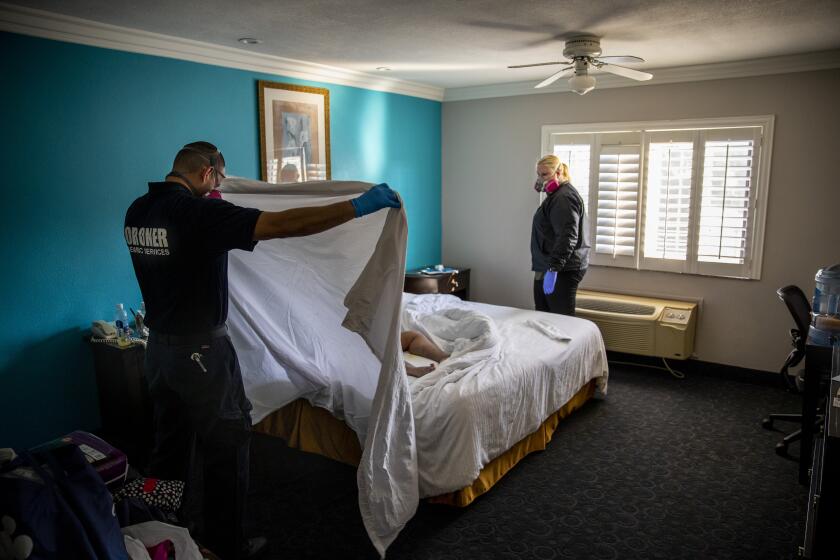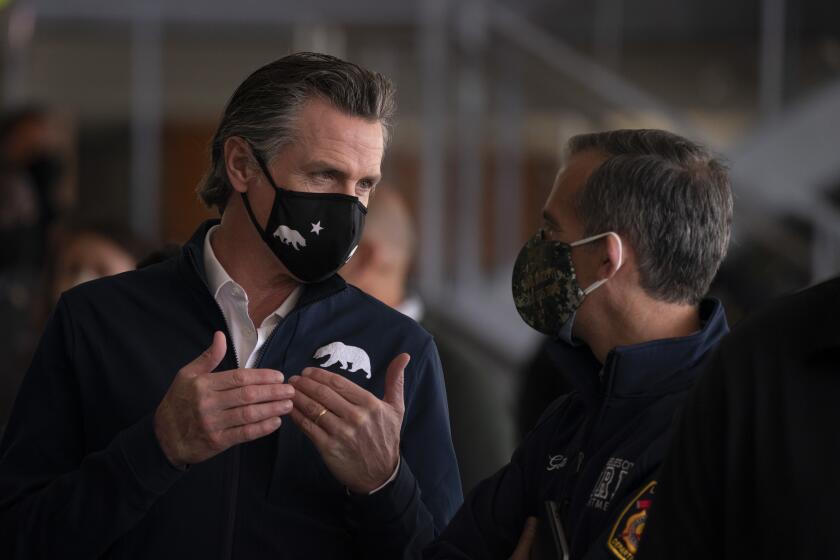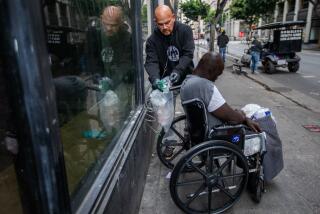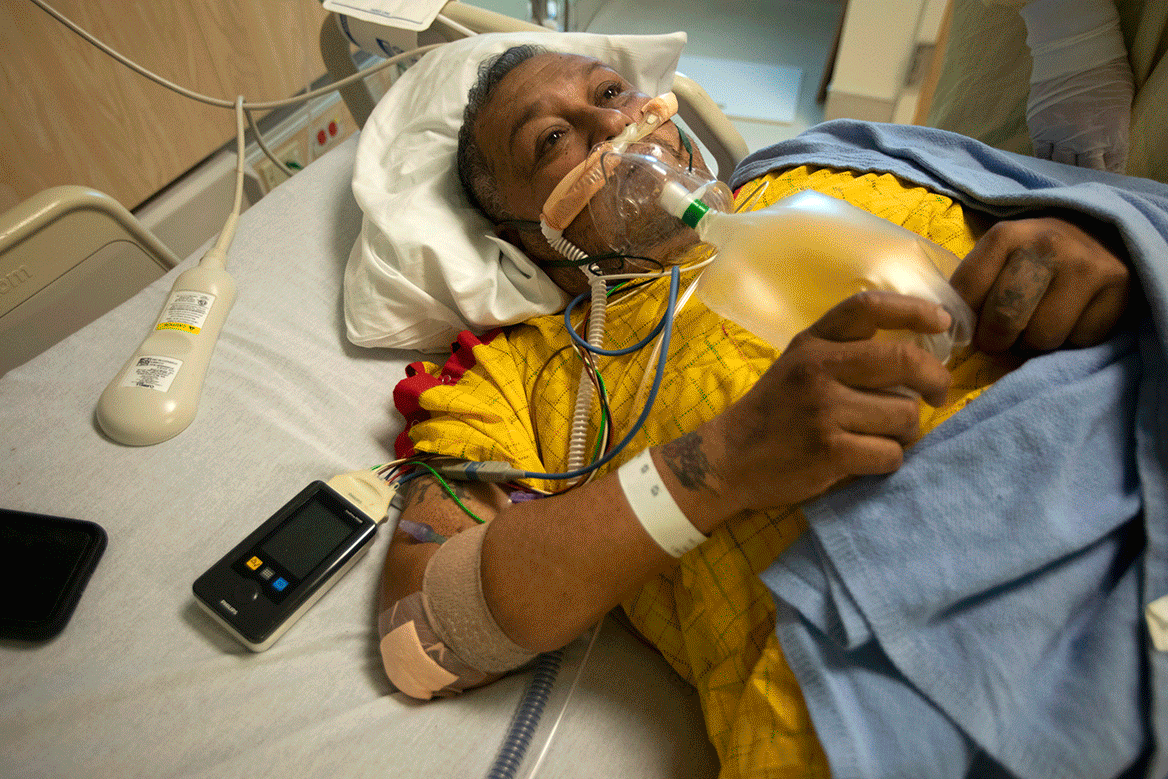
- Share via
Gilbert Torres sat in his hospital bed, sheets wrapped around his legs, clutching his phone with trembling hands.
Three weeks before, he was working his shift at a truck wash on South Alameda Street, counting the minutes before he’d be home playing with his 5-year-old boy.
Now such moments were just a beautiful dream.
In the hallway, nurses peered through the glass doors, wiping their eyes as they watched him confront the possibility that he might have minutes left to live. He was only 30 years old. He looked desperately alone.
Nurses in white Tyvek suits and respirators stepped into the room to set up the ventilator.
Torres said goodbye to his girlfriend of nine years on video chat, laboring to get the words out. Even on high-flow oxygen through his nostrils, he struggled to breathe. He hadn’t slept in days.
He watched a team of nurses and doctors suit up in the hall.
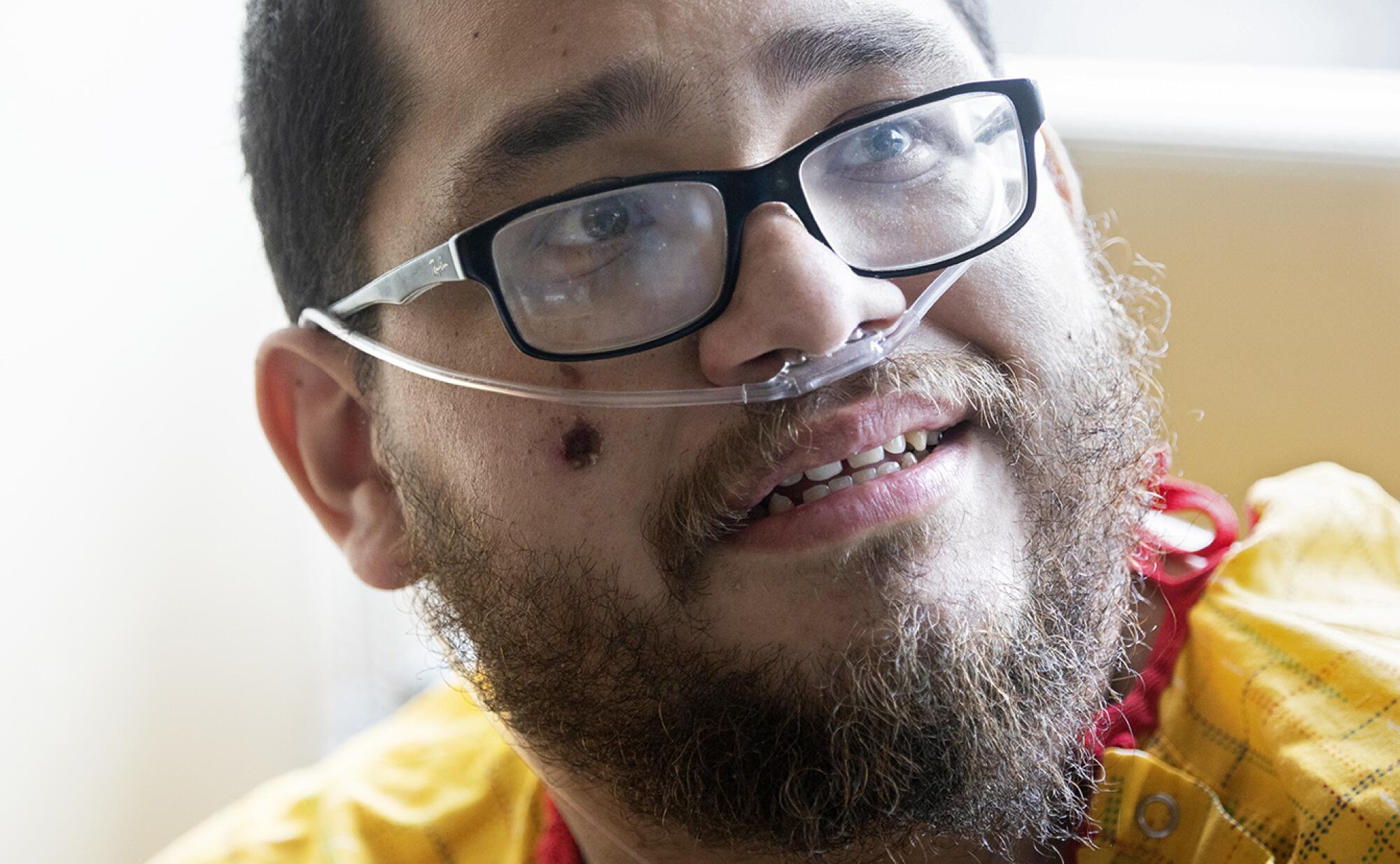
“It’s happening,” Torres told her. “They’re going to intubate me.”
“Everything is going to be OK,” she assured him.
“I’m scared. I don’t want to die.”
Tears streamed down his cheeks. His body shook.
An emergency room doctor leaned in and told him it was time.
Torres turned off the phone.
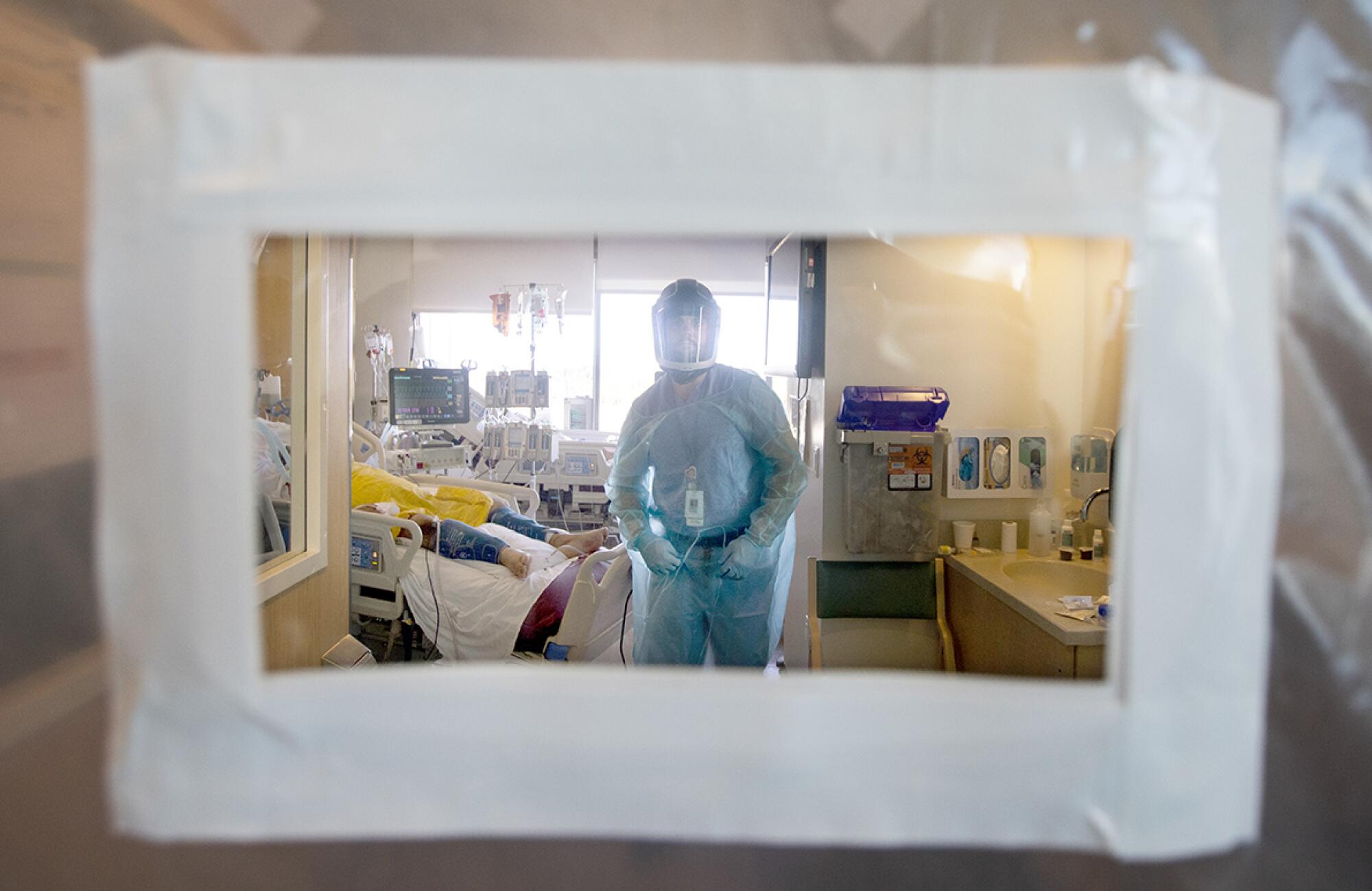
The team came in. Wearing a bulky hood over his respirator and mask, the doctor stood behind him with the laryngoscope, ready to insert the breathing tube. A nurse released sedative and paralytic medications into Torres’ bloodstream.
He closed his eyes, clasping her hand.
:
They call it el tubo, and it haunts places like South Los Angeles, the Latino-majority neighborhoods hit harder by COVID-19 than almost anywhere in the U.S.
Intubation has become more than a medical procedure. It represents the terrible crossroad of this disease: the moment patients must decide whether to have a tube inserted into their trachea so a machine can take over their breathing.
While the procedure itself is relatively simple, it can spin out of control within seconds. The airway team generally puts the patients to sleep and stops their breathing. If their blood pressure isn’t stabilized as the rush of adrenaline abruptly falls off, or a doctor cannot secure the tube at the right spot quickly enough, oxygen levels drop precariously, leading to organ failure and death. But for people with severe COVID-19, the procedure can be the last bid for survival.
For an investigator with the L.A. County Dept. of Medical Examiner-Coroner, the job on this day is to piece together the puzzle of the victim’s life and death — and to stay healthy.
Arriving at this juncture presents one of the most agonizing choices a patient or family may ever have to make. Most people have no plan for what to do.
The only other option is to struggle on, with doctors managing the pain and anxiety with medication, as they lose oxygen and blood pressure and likely fall into cardiac arrest.
Most patients at this late stage will die whatever road they choose. While chances of survival might be higher on the ventilator, doctors say, those who recover could be left with major disabilities, including brain damage, severe respiratory problems and kidney failure. Younger people with no major underlying medical conditions fare better.
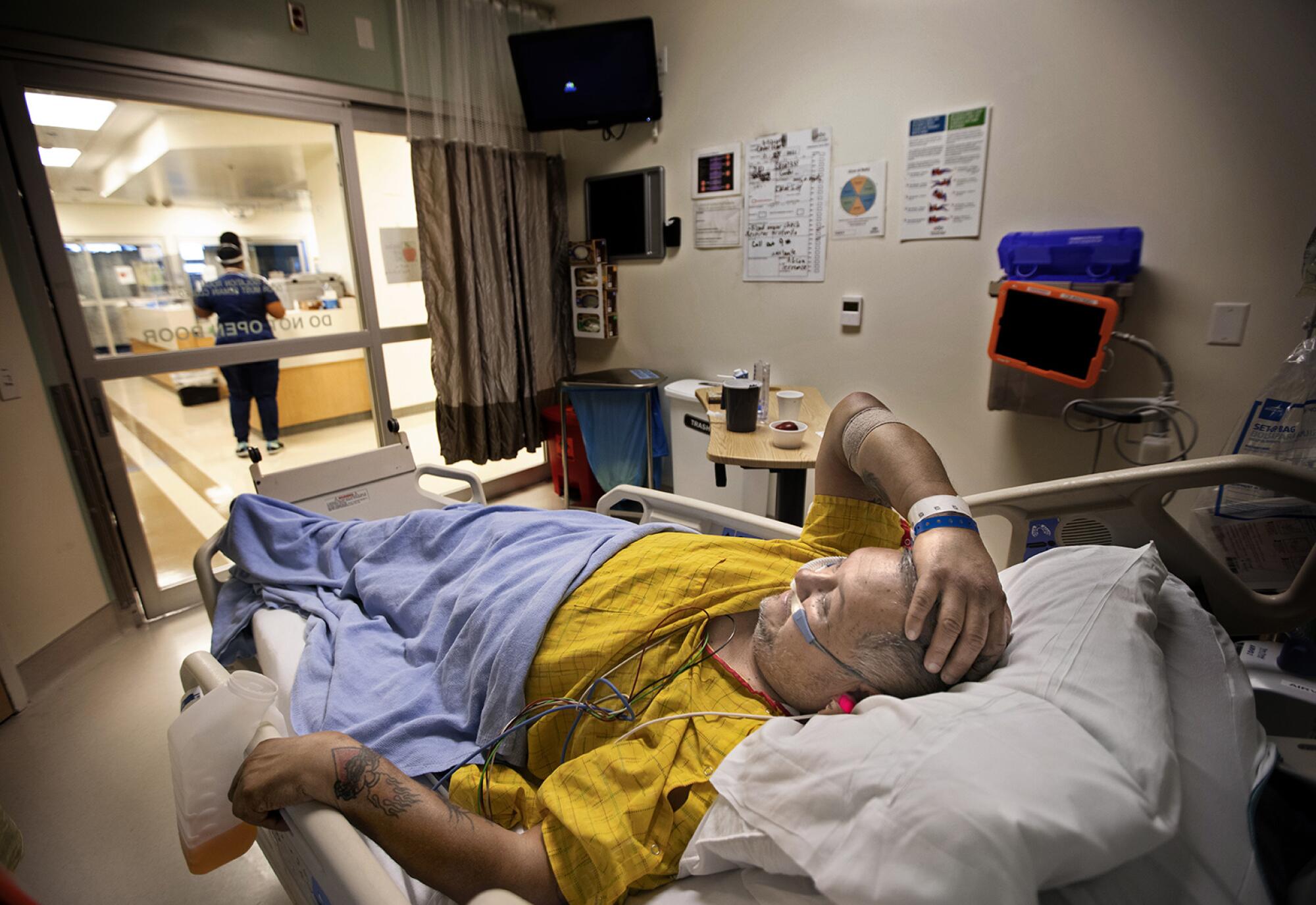
With so many people going to hospitals for COVID-19, many South Los Angeles residents have stories about going on the tube: the uncle who died just minutes after hanging up with his family. The friend’s father who came out alive but would need dialysis the rest of his life. The aunt who died after three weeks in a coma. The middle-age cousin who is recovering.
At the heart of the suffering is Martin Luther King Jr. Community Hospital, a privately managed, high-tech facility that replaced the troubled county medical center that had closed in 2007. The Willowbrook hospital has been packed with patients facing the terrible choice.
Mariano Zuñiga Anaya, 57, knew all about el tubo. His older brother died in May on a ventilator in Mexico.
Now Zuñiga was sick in the small apartment in Florence-Firestone that he shared with his daughter Ana and her 5-year-old girl and 2-year-old boy.
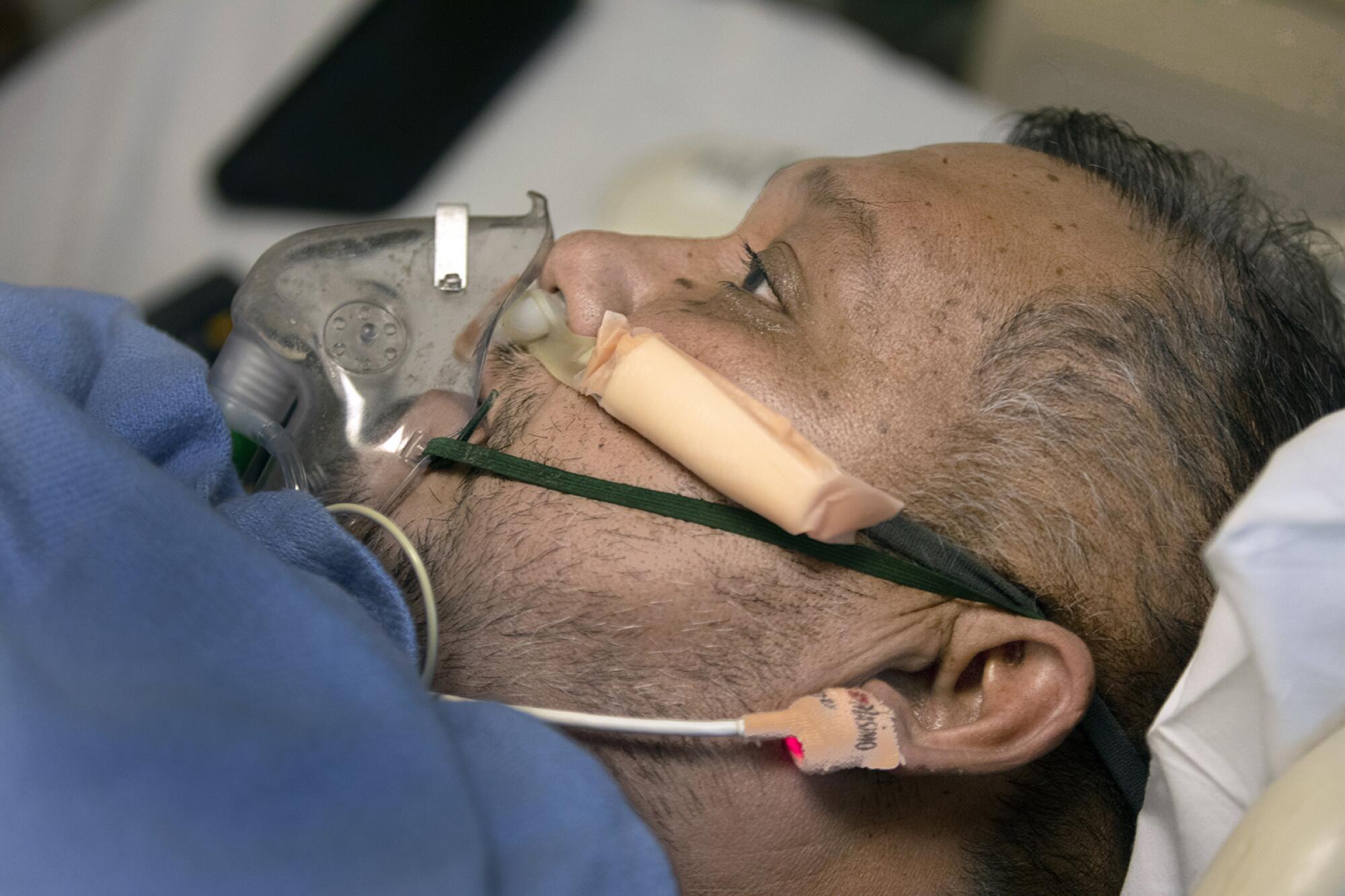
Zuñiga was a traditional show-no-weakness father who had turned into a playful, doting grandfather. He let his granddaughter paint his toenails and grandson draw “tattoos” all over his body with markers. He helped her learn how to read and write, and loved to listen to the stories she imagined up. They loved their abuelito.
Ana Zuñiga Diaz, 30, relished this new side of her father, and she was terrified now. Her mother and older sister still lived in Michoacán, and all the weight of his illness fell on her.
On Jan. 22, her dad was too weak to get up, could not eat and had a frantic, ragged cough. He had major health problems already, weighing over 275 pounds, with diabetes, hypertension and high cholesterol. He recently had lost part of a toe due to complications of diabetes.
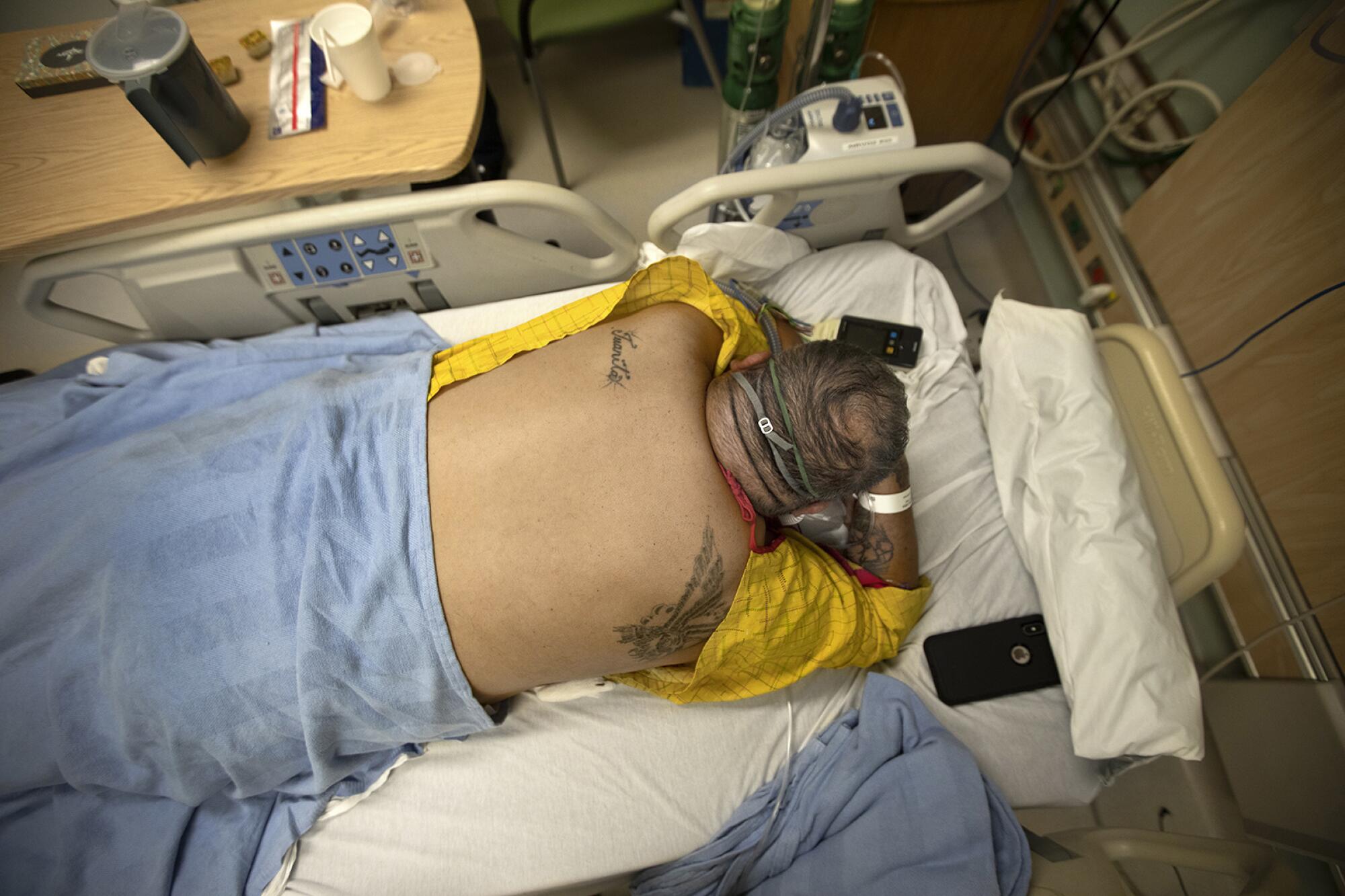
Ana called her sister, Leslie, to explain his bad condition.
“She’s exaggerating!” her dad called out.
The family in Mexico feared if he went to a hospital he would be forced on a ventilator. Their uncle was dead within four days of getting intubated. They could not bear losing him the same way.
Bob Harris told his family he didn’t want to be on a ventilator, but when his family wasn’t ready for him to stop fighting COVID-19, he agreed to be intubated. One week on the ventilator turned into three, and the Harris family faced a terrible decision.
Back home in the mountain town of Zacapu, Mariano was a booming, fun-loving presence — the worker who left as a teenager, diligently sending money back for nearly 40 years. Twice a year he would return, hosting big fiestas with mariachi bands. He had a deep laugh and loved to joke and tell stories. Ana suspects he got COVID-19 on his flight back to Los Angeles after the New Year.
The family wanted him to stay out of the hospital, fearing it would be his death.
As Ana spoke to her sister, Mariano started coughing so violently it sounded like he was drowning. She hung up and called 911. The paramedics came and told him he had to go to the hospital. His blood-oxygen level was dangerously low. She felt helpless as they loaded him onto a gurney and took him away.
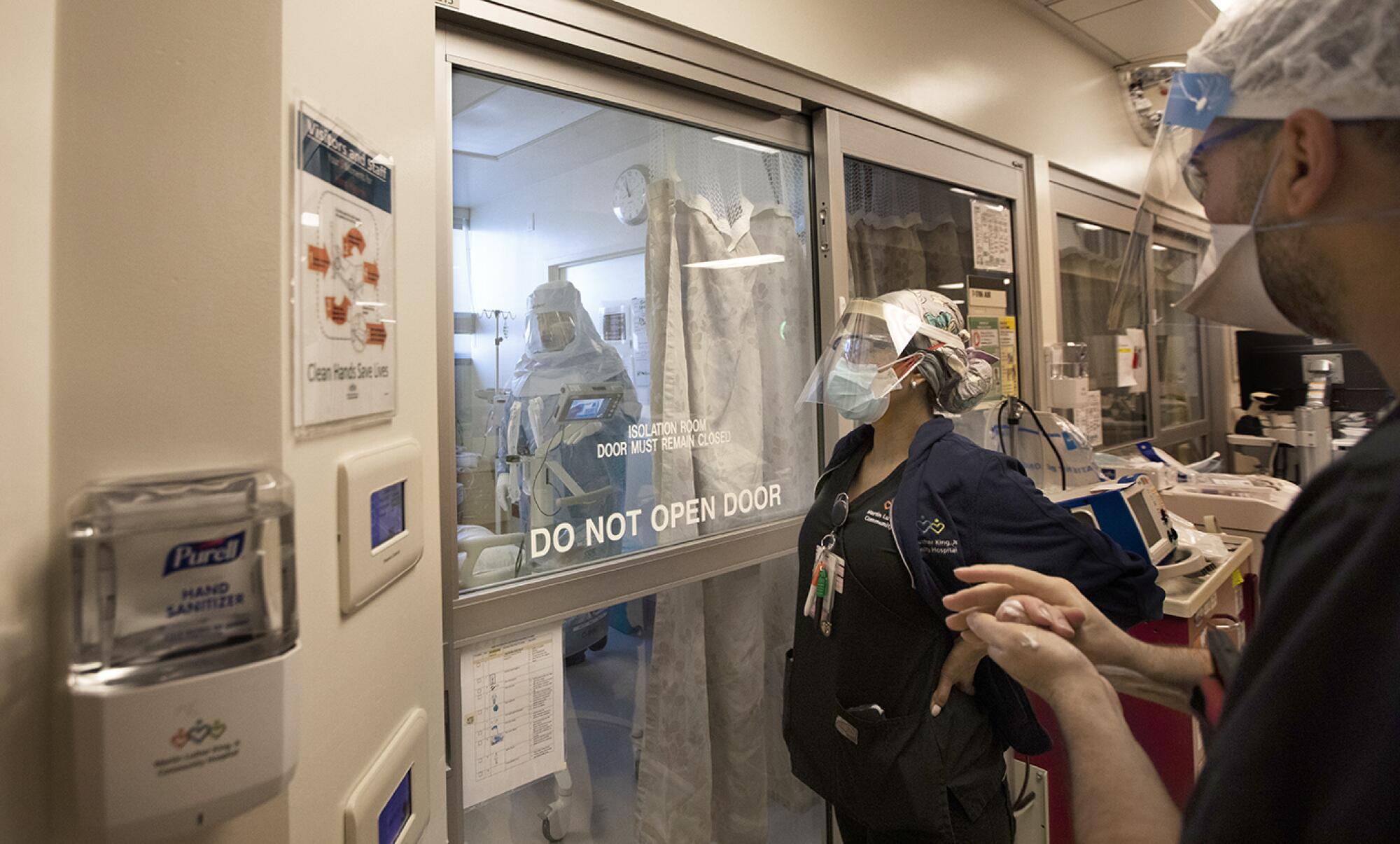
::
Torres, the young father, lay on his belly, unconscious on the fifth-floor ICU three days after his intubation. His ventilator pumped with its eerie hiss-tap-tap metronome. Nurses talked gently to him as they repositioned him or checked his settings.
Dr. Joseph Meltzer, a UCLA critical care specialist working at the community hospital during the surge, had told Torres that he had to be intubated. But he made a promise: “We can get you through this.”
Now, Torres was stable, but his oxygen saturation fell every time he was turned to lie on his back, which he needed to do for eight hours a day to avoid blood pooling. Meltzer turned up the pressure on the ventilator to bring his oxygen up. But too much pressure, over too much time, could damage the tiny sacs in the lungs where oxygen was absorbed into the blood and carbon dioxide released, reducing his odds of surviving.
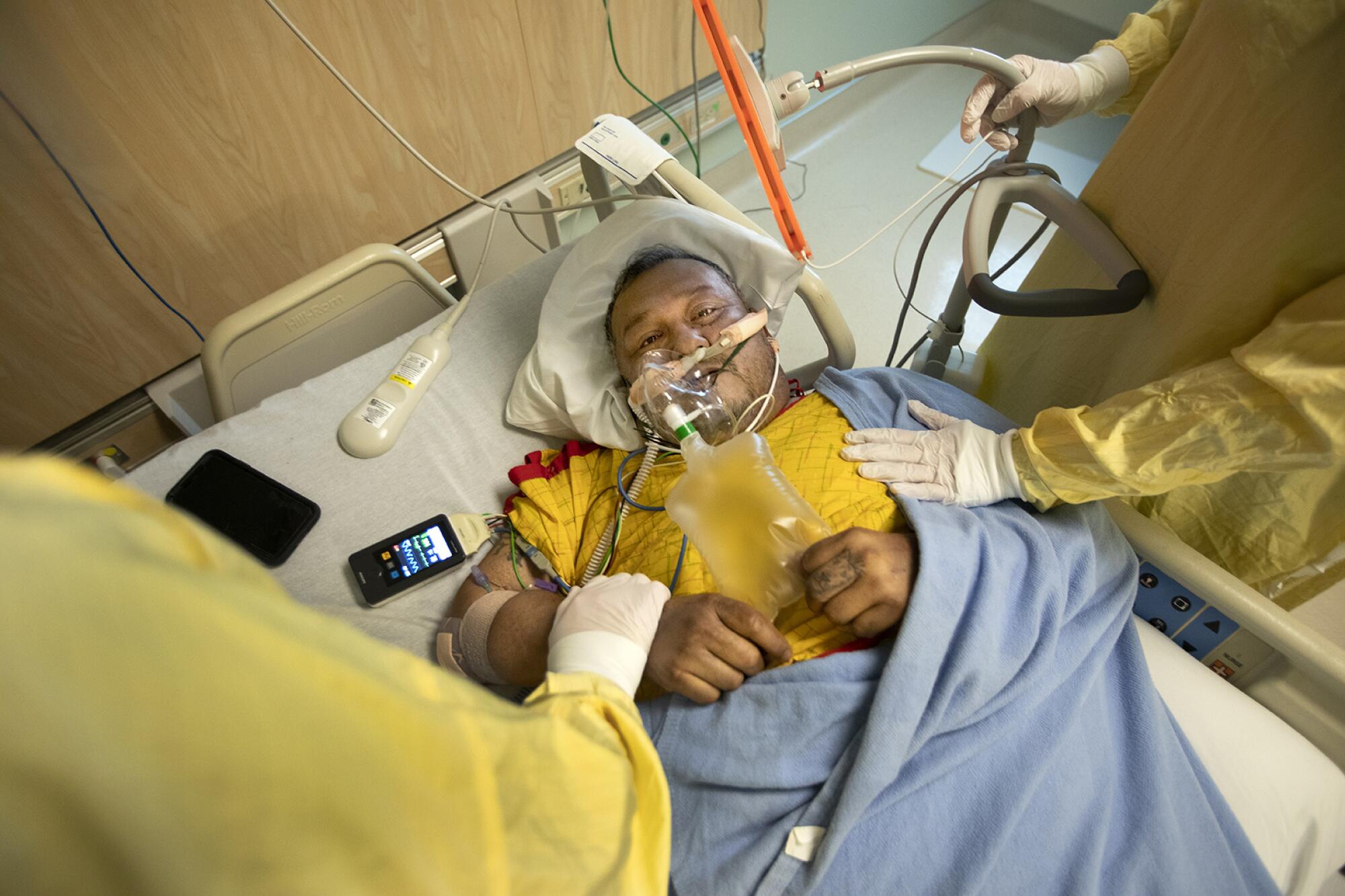
The same morning, Zuñiga was wheeled to the south wing of the telemetry unit on the first floor, room 710 — four doors from the room where Torres was intubated. Since the surge, the unit was filled to capacity, and became the transition zone where COVID-19 patients recovered enough to go home, or went to the ICU on a ventilator.
Zuñiga was in bad shape. Doctors put him on high-flow oxygen through his nose. They set the machine to 60 liters per minute. Only the ventilator could deliver more.
He lay on his side and his shortness of breath gradually abated, but his blood-oxygen level remained perilously low. He was at risk of organ failure. Talking or moving made it worse.
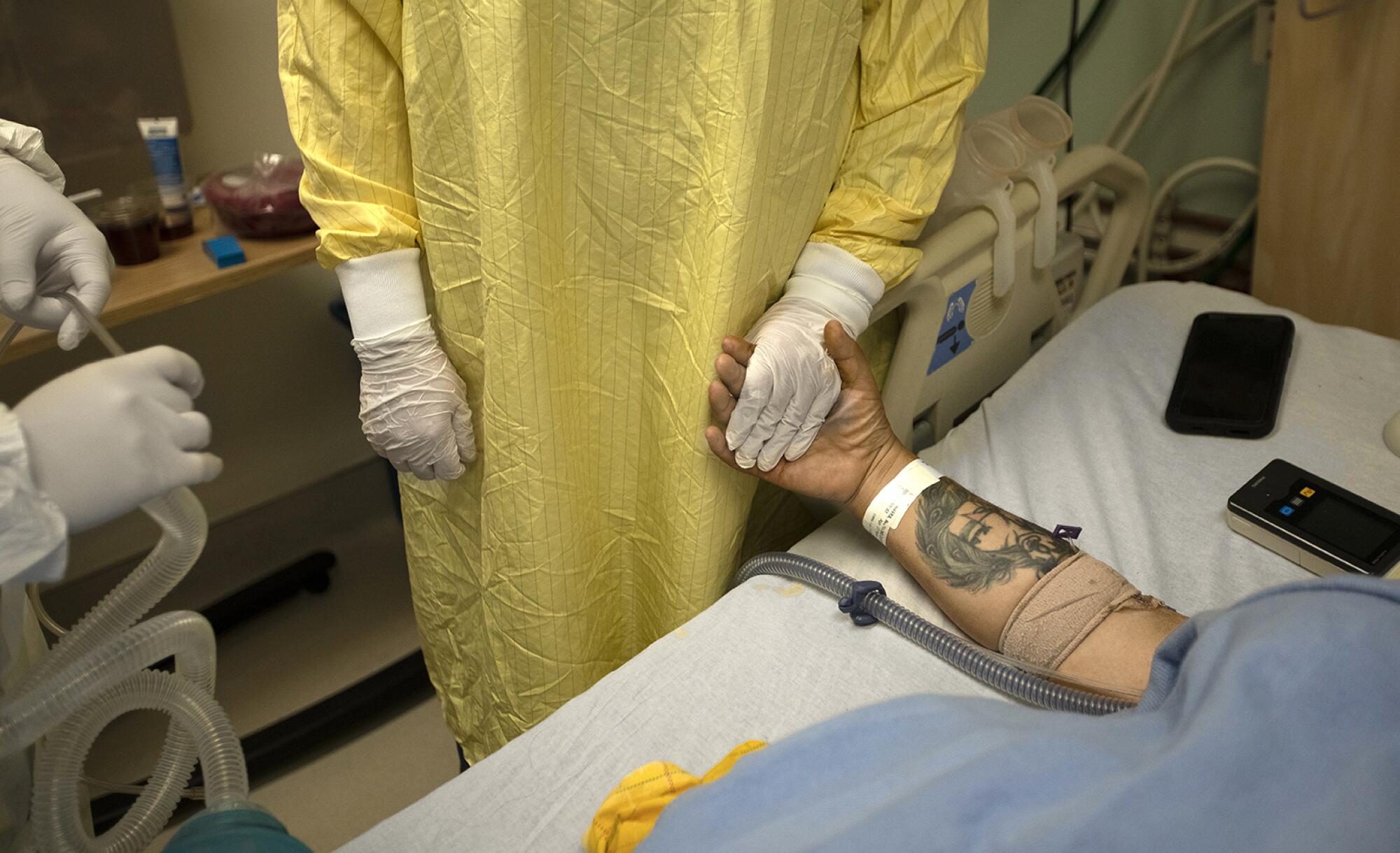
His granddaughter Hayley sent him little audio texts. “You’re going to be alright grandpa,” she said. “Echele ganas.” Give it your best.
Ana called him every morning.
“How are you feeling, Papa?”
“Estoy bien,” he would say in a robust voice. I’m good.
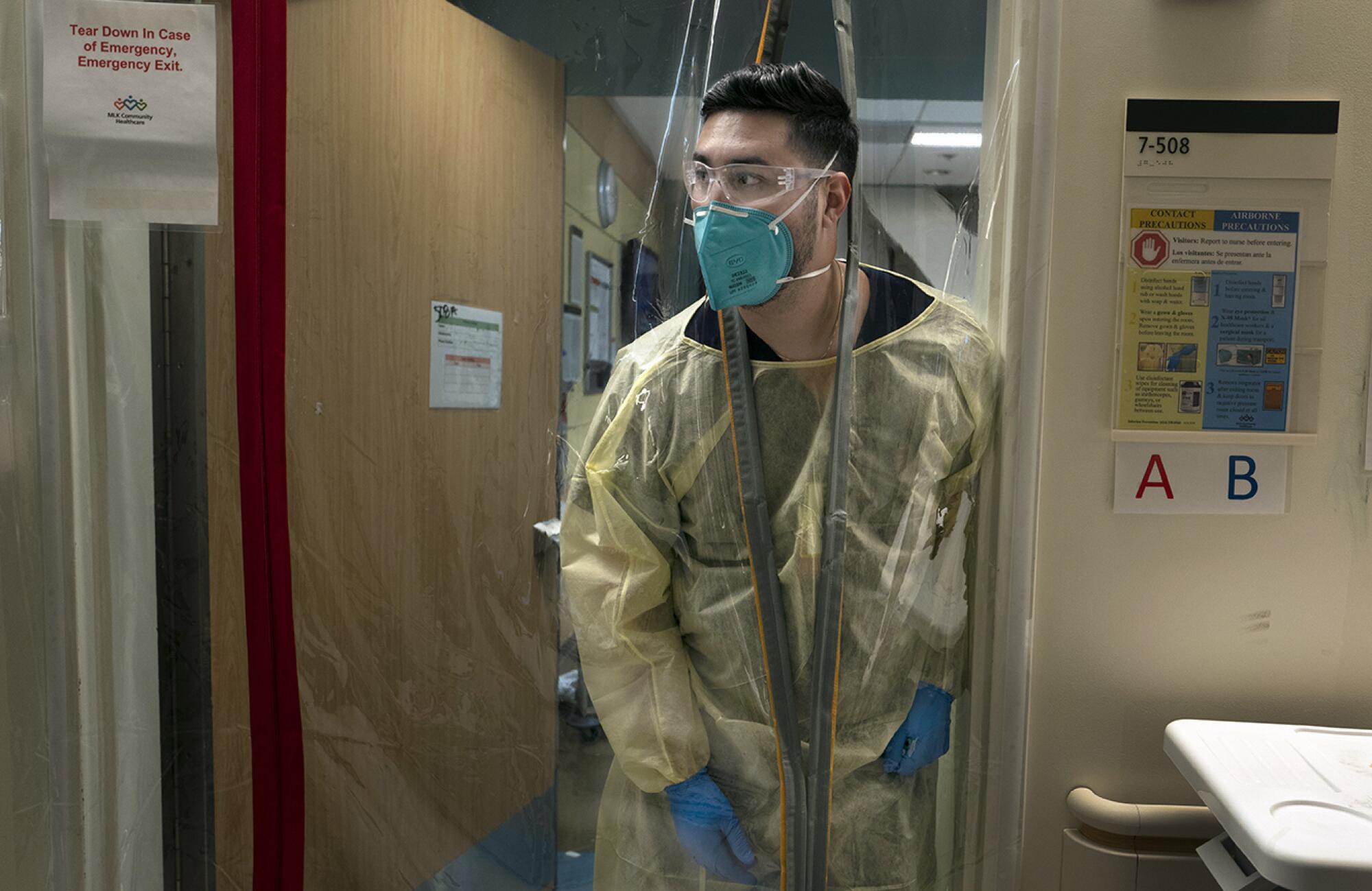
But the doctors told her he was at a critical point. His oxygen delivery was at the maximum setting, and his blood saturation was not improving. They brought up the possibility of putting him on the ventilator, but he had refused it. When a reporter asked him why one day, he declared: “For fear, nothing else.”
The next day, Torres appeared to be rounding the bend. His blood pressure and oxygen levels were stable enough to gradually lower the pressure on the ventilator, to let his own breathing slowly take over.
On Jan. 24, Dr. Jason Prasso, a pulmonary and critical care specialist, decided Torres was ready to get off the ventilator. His team eased off the sedation.
Gov. Gavin Newsom announced the move, which starts in March, in an effort to reopen schools.
But as Torres came to a low level of consciousness — still deeply blurred by the fentanyl — he grew agitated. They gave him an anti-anxiety medication as the respiratory therapist began to pull out nine inches of tube from his trachea.
When it came out, Torres panicked, struggling for air.
“Please intubate me,” he said. “I beg you!”
He grabbed Prasso’s hand.
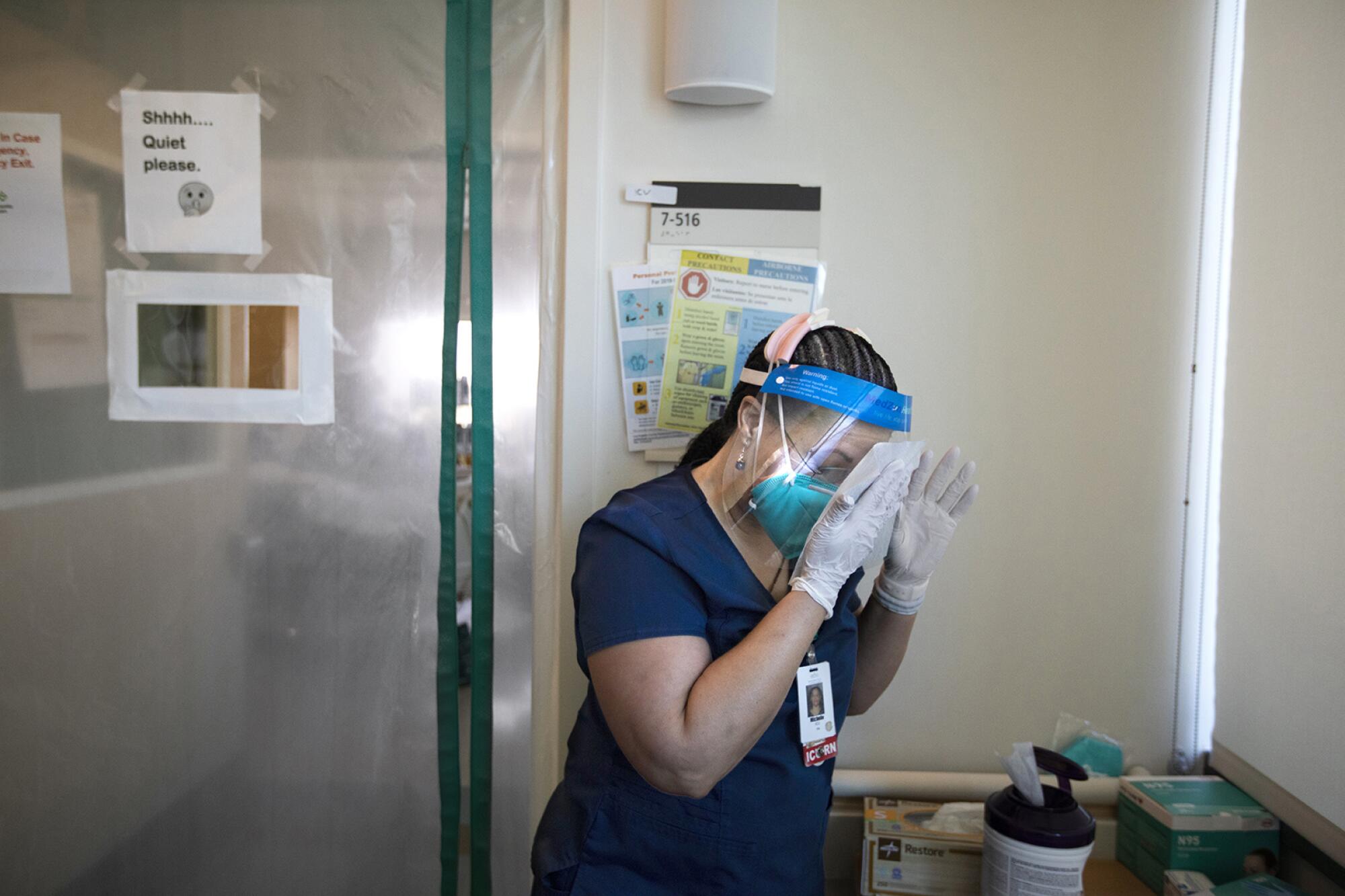
“Just relax, breathe,” the doctor said. “I can’t put it back in you. You’ve made it through so much.”
“Imagine you’re on a beach in Hawaii,” someone said.
“Please!” said Torres. “Knock me out, put me under.”
When the anti-anxiety meds kicked in, Torres floated around in a fog. Why was he in Hawaii? He didn’t have his glasses, so he couldn’t see anything but muddled colors, blue sky in the day, circles of light in the dark night. The sounds were so jarring and constant, so alien: the beeping of the monitors, the hiss of his roommate’s ventilator, muffled voices through the door.
Every so often the loudspeaker blared “Code Blue.” “Oh my God somebody is dying,” he thought. He started to cry.
In a couple of days, his mind started to sort itself out. But he had no memory of his days before the intubation or how he got to the hospital. In his haze, he tried to figure out why he was taken to one in Hawaii.
::
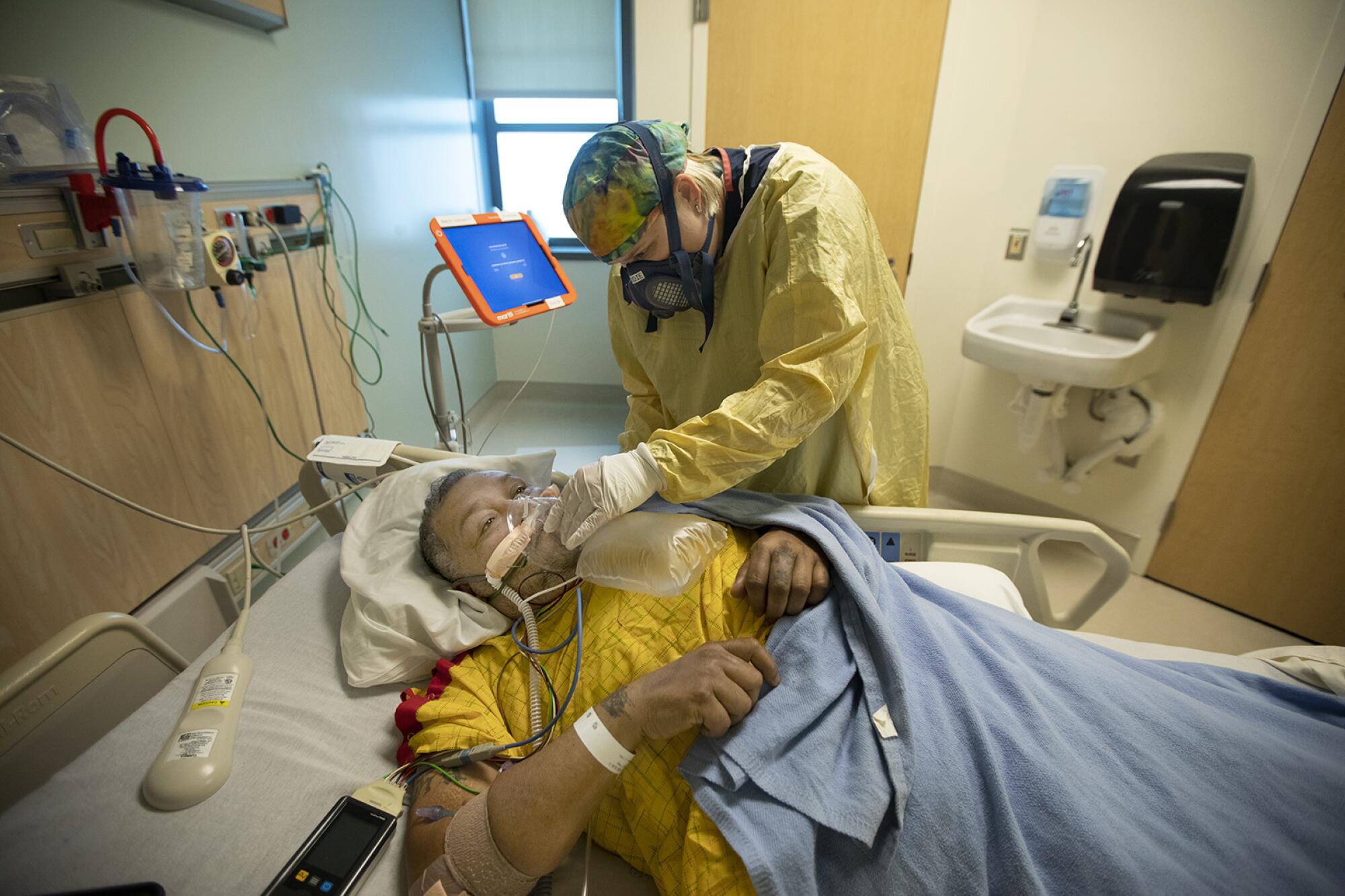
Zuñiga continued to struggle after four days on maximum oxygen.
Dr. Krupa Gandhi noticed that “DNI” — do not intubate — was written in his notes. Seeing that he was only 57, she wanted to make sure that he understood what this meant.
She stepped into the room with a live translator on an iPad stand to speak with him in Spanish. Gandhi explained that if his vitals started to drop, the only way to save him might be the ventilator.
“I don’t want to be intubated. I want to die in peace,” he said. “I don’t even understand why you’re asking me this.”
He seemed to think he was doing well.
“You’re on a high oxygen requirement, and if you need more, you’re going to do worse,” she explained. “We have to know what your wishes are, so we have this conversation early.”
Zuñiga was adamant about not being intubated.
Hear from staff photographer Francine Orr about how she approaches her work in challenging, often dangerous situations.
Even though he neared a point of no return, Zuñiga looked relatively relaxed. He wasn’t gasping for air, breathing rapidly, shaking or sweating. Every time a Times reporter visited him to see how he was doing, he always announced, in his strong voice: “Bien.”
“I think he just felt so comfortable that he’s like, no, I don’t need a tube,” Gandhi recalled shortly after her conversation. “I don’t know if his decision will change if he starts becoming more uncomfortable.”
Upstairs, Torres was moved back to telemetry, transitioning through the unit in the right direction this time. He could sit in a chair and look out the window. He had gone down the oxygen requirement chain to a simple cannula delivering a low flow of oxygen through his nose.
He was deeply shaken. He talked to his girlfriend, Lisseth, on the phone but couldn’t bring himself to talk to his 5-year-old son, Austin. Just thinking about it brought him close to sobbing. He missed him so much, and he didn’t want his boy to see him cry.
He was racked with anxiety over the trauma of the last week.
“It was the most scariest experience you could possibly have. You know why?” he recalled in a shaky voice. “Because you’re alone. Because you’re alone. That’s it. You’re alone.”
On Feb. 1, three days after Zuñiga rejected any option to be intubated, Dr. Ameer Moussa noticed that his oxygen and blood pressure were dropping. This would be the point to intubate before his organs failed.
“How are you feeling?” Moussa asked.
“Bien,” Zuñiga said.
“Any pain?”
“None.”
Moussa told him his condition was getting worse, that he could go into cardiac arrest at any moment, and asked him again if he wanted to be put on the ventilator.
“No,” Zuñiga said.
“Are you sure?” the doctor asked.
Zuñiga wavered. “Ask my daughter.”
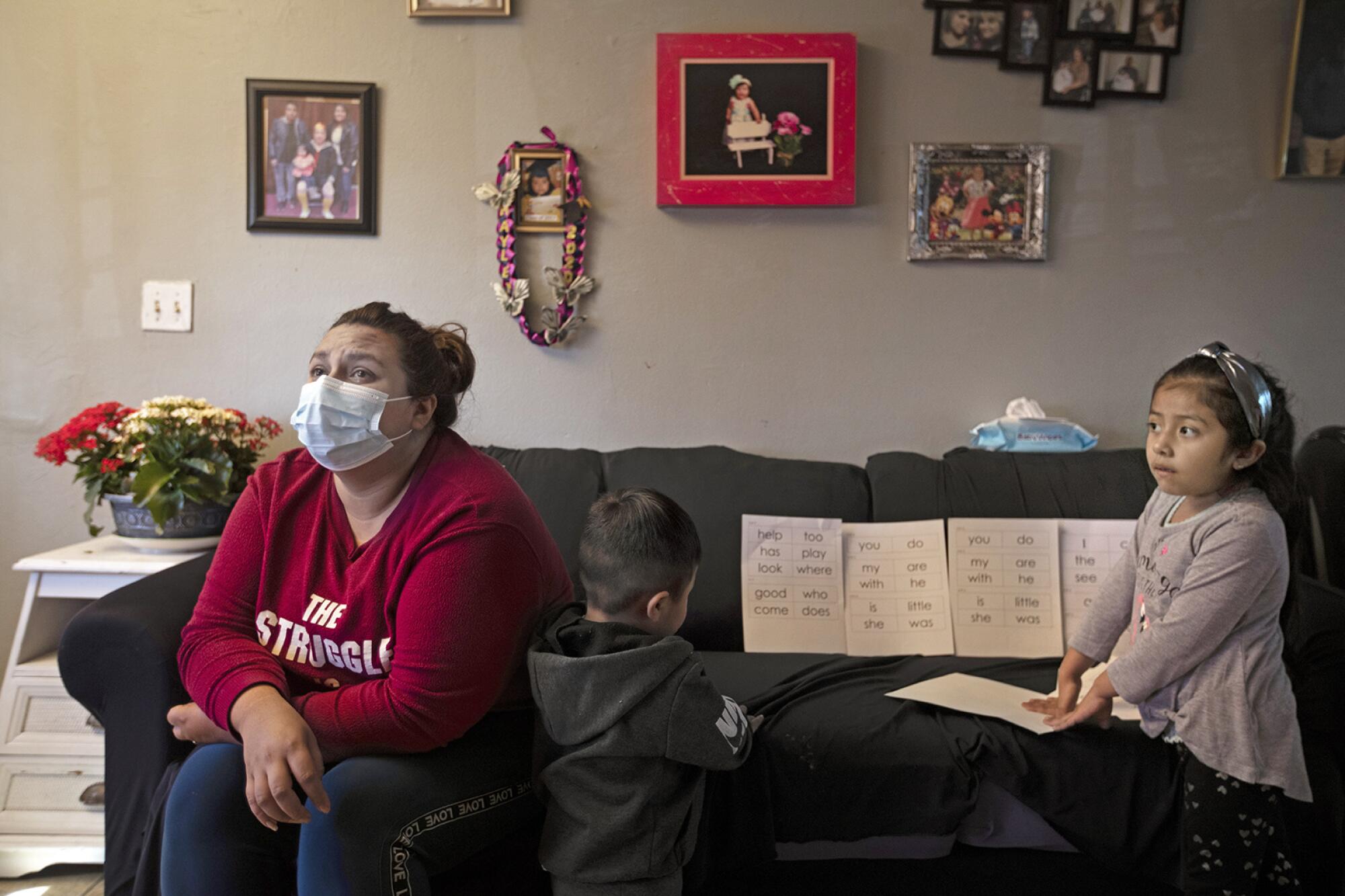
The call from Moussa spun Ana into despair. She did not want this decision on her shoulders. Over the next hours, she called her sister in Mexico, then a cousin who was a doctor, then her dad.
Every time her father talked to her, his oxygen plummeted.
“These calls are making him worse,” said the nurse watching the monitors.
Ana finally called Moussa with the consensus that if he went into cardiac arrest they should try to resuscitate him and put him on the ventilator then — but not before. The doctor sighed. That didn’t make sense.
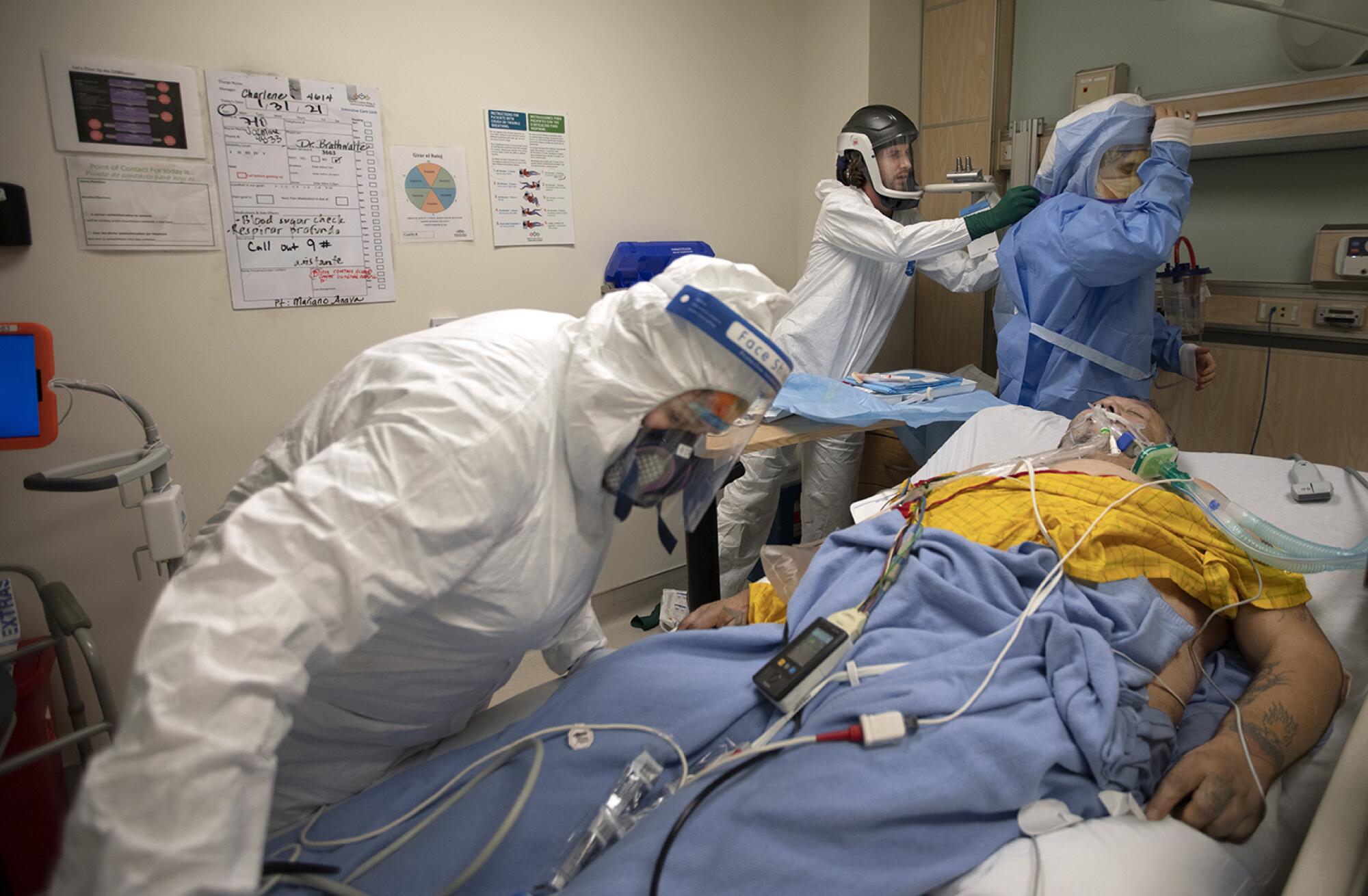
He went back to Zuñiga with the iPad translator, trying to understand his thinking.
He asked him why he wanted to be intubated only if his heart and lungs stopped.
“Vivo,” he said. Alive.
“If you want to live, then the best thing is to intubate now and not when it’s too late,” Moussa said.
Zuñiga was silent. “Does it hurt? he asked.
“No, I put you to sleep.”
Zuñiga stared up at the ceiling, thinking it over.
“Esta bien.”
::
Within 20 minutes of Zuñiga’s decision, Dr. Stefan Richter arrived from the ICU to carry out a procedure he had done hundreds of times — but which could still go disastrously wrong.
COVID-19 patients have usually been under a flood of adrenaline for days. The moment the sedative hits the brain, that drops off and their blood pressure tends to crash.
A minute later, the paralytic hits, and the patients’ breathing stops. With COVID-19 patients who were already severely oxygen deprived, it leaves the doctors seconds to thread the tube through the larynx into the trachea. And that small gap, next to the opening of the esophagus, can be hard to find.
Richter said a fraction of patients die within minutes or a couple of hours after intubation.
A dozen nurses and specialists waited outside room 710, ready for any possible emergency. Two nurses and a respiratory therapist assisted the doctor in the room.
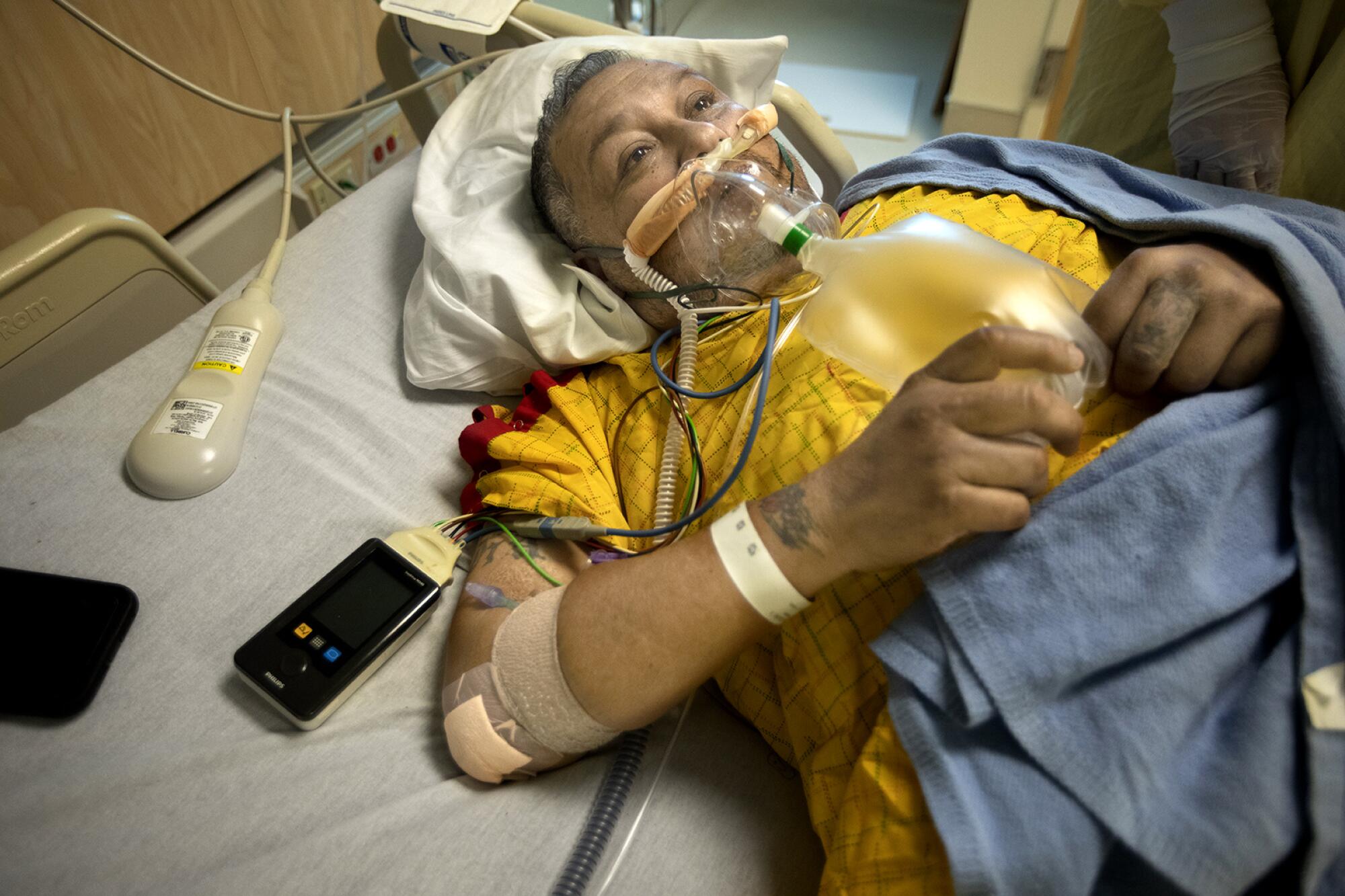
At the center of this swirl of activity, Zuñiga lay still, silent and scared, tears glistening in his eyes.
The ICU nurse released the short-acting sedative etomidate into his IV, followed by the paralytic rocuronium. Zuñiga fell asleep almost instantly, avoiding one of the very rare but terrifying moments a human can experience: having the paralytic hit while they are still awake.
Richter took the sickle-shaped video laryngoscope and ran it down the right side of Zuñiga’s tongue, pushing it to the side to clear a path to the larynx. A camera and light at the tip of the sickle guided the way, displaying the image on a small screen on top of the scope. Richter guided it through folds of excess tissue, looking for the opening.
Zuñiga’s oxygen monitor rang an alarm as his blood saturation dropped below 80%. The respiratory therapist silenced it.
“Pressure is dropping; why don’t we start Levo?” Richter asked the ICU nurse.

Levophed supplemented his falling adrenaline, constricting his blood vessels to build the pressure back.
Richter spotted the opening, a small hole between the vocal cords, and ran the tube down a groove in the scope to guide it through. He stopped at 26 centimeters below Zuñiga’s front teeth. He pulled out the stiff wire that kept the tube from crimping and asked the respiratory therapist to inflate “the cuff” — a balloon around the tube that seals it to the trachea, keeping the pressure in the lungs.
A probe attached to the ventilator showed carbon dioxide coming out of the tube, a good sign it was in the right spot. Richter still wanted to be absolutely sure the tube hadn’t gone down the esophagus, which could be fatal if not fixed instantly. He took a stethoscope to Zuñiga’s stomach to listen for any airflow there. There was none. He listened to the lungs with his stethoscope and could hear air flow.
They all stared gravely at the iPhone-sized monitor on Zuñiga’s chest. His oxygen had crashed to 6%, a level that would rapidly kill him.
His blood pressure was down too, at 70/30, creating a potential shock to the kidneys and other organs.
The therapist let a burst of air from the ventilator to open any air sacs in the lungs that had collapsed during the procedure.
Slowly, Zuñiga’s numbers began to recover as the ventilator and vasoconstrictors did their work.
He was wheeled to the ICU with oxygen numbers in the low 90s and blood pressure of 100/70. But the initial crash in both loomed as a bad omen.
::
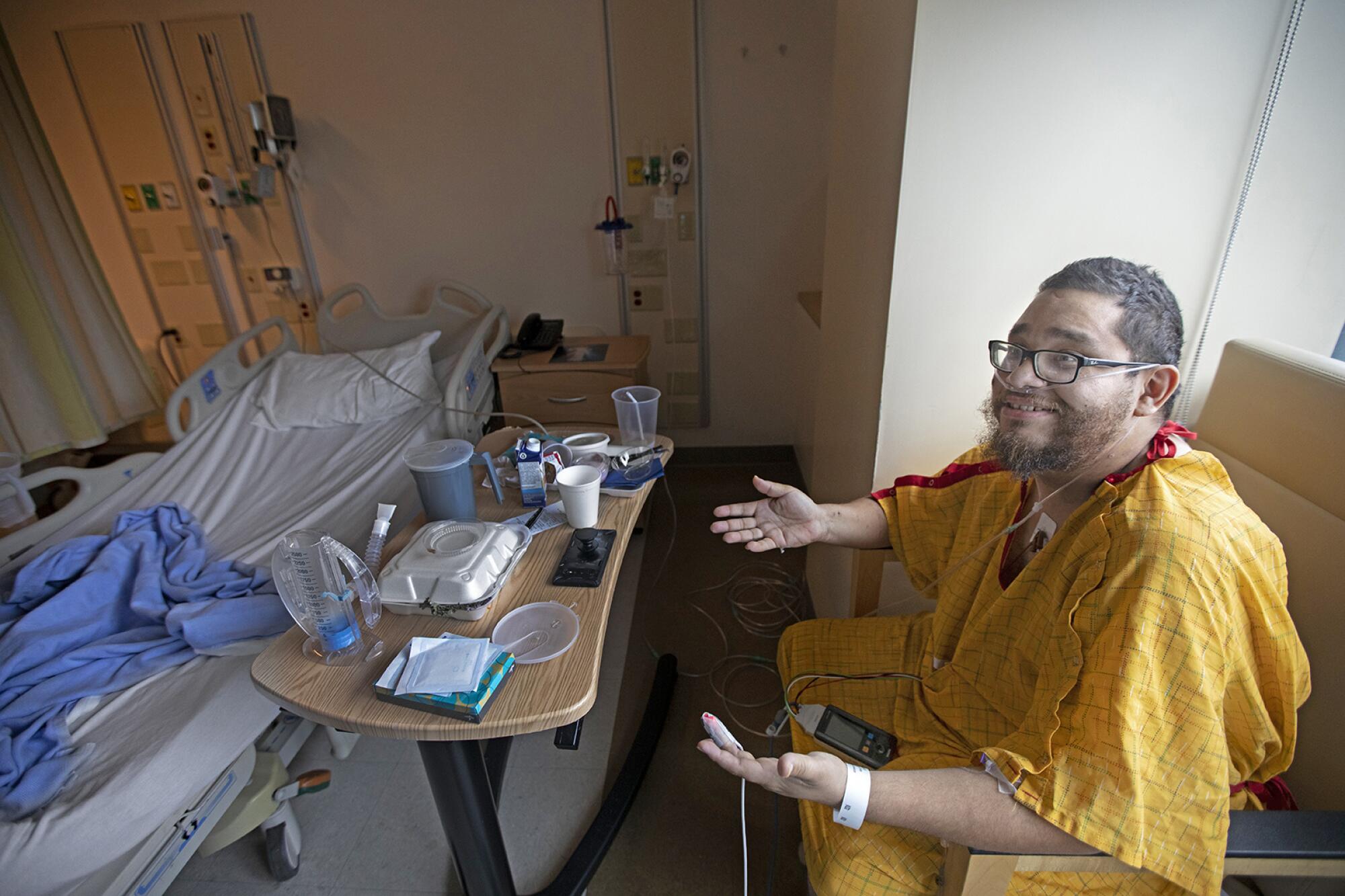
On the bright, crisp morning of Feb. 6, Torres was ready to go home. He beamed in happy disbelief. He put on an Avengers T-shirt and packed up his items.
A doctor came in and listened to his lungs and advised him to be alert for any new symptoms. He was still weak and needed oxygen. He’d have to come back to the post-release clinic in a week for doctors to check his progress.
Torres was wheeled out the modern glass entrance of Martin Luther King Jr. Community Hospital, smiling like a little boy.
He wept as his girlfriend walked up to him. She gave him a long hug.
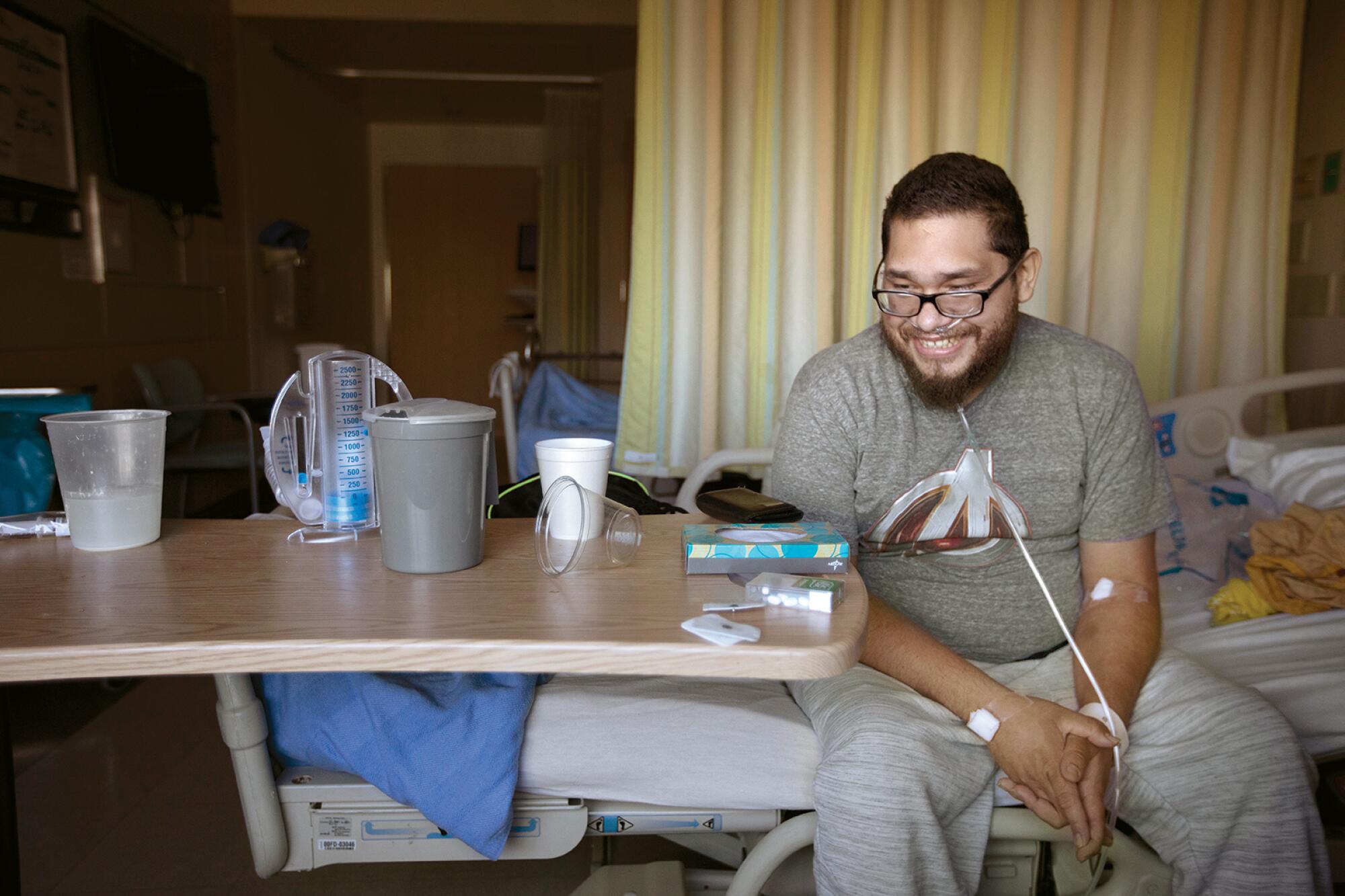
The senses overwhelmed his emotions: her smell and touch, the sunlight and the cool breeze. “I missed you so much,” he said.
They loaded the wheelchair in the back of her sister’s car. He got in the backseat with his oxygen tank.
He knew he’d never be the same. Since he left the ICU, he promised God he would be a better man, someone his son would be proud of. He had made this vow over and over, and he had no doubt he would keep it.
“Can we just drive awhile?” he asked.
He opened the window and took as deep a breath as he could. He wanted to stay outside forever.
As they rolled along Central Avenue, he reached out the window and let his cupped fingers sail through the air, angling up and down, right and left, such a simple joy flying his hand in the wind.
::
At that very moment, Ana Zuñiga was on the fifth floor. Prasso had called her earlier that morning.
Two days after the intubation, Mariano Zuñiga’s kidneys shut down and he had to be put on continuous dialysis. Healthy kidneys use carbon dioxide to regulate blood acidity. His failing ones put a larger burden on the lungs to expel the gas.
Zuñiga’s acid level was rising while oxygen and blood pressure were dropping.
This was the end. Earlier that morning, Prasso stopped the dialysis and returned all his blood to his body to stabilize the pressure, just to give Ana enough time to come see him.
“There’s nothing else I can do for him,” Prasso said.
A nurse gave her a long hug.
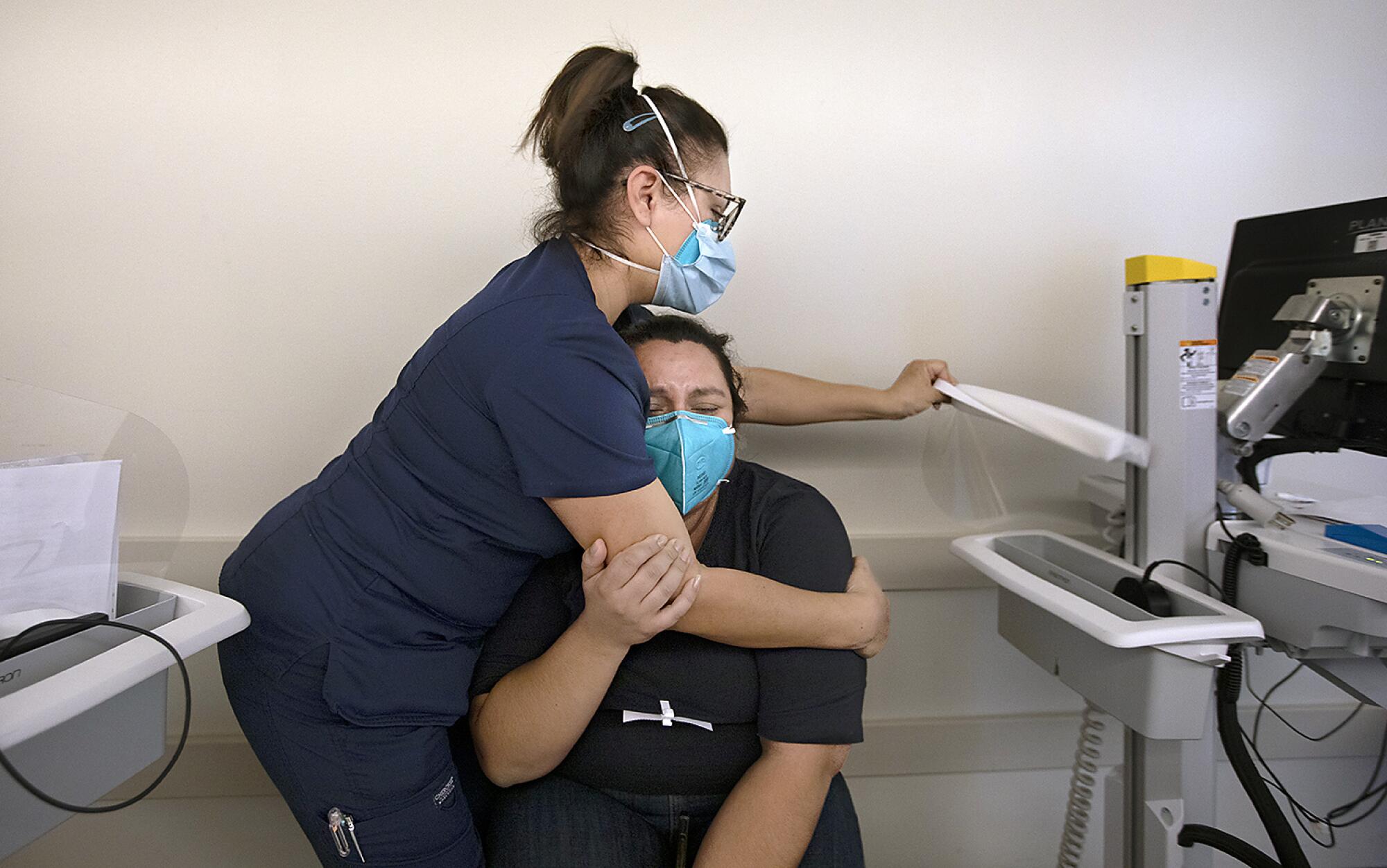
Prasso explained that without dialysis her father was going to die within a day.
“Now if he could step out of his body right now, understand everything that was going on, how do you think he would want to pass?” he asked. “Would he want to pass attached to all these machines, or pass more naturally?”
“He wouldn’t want to die on all these machines,” she said without pause.
He had the nurses give her father medication to tamp down any pain, nausea and shortness of breath. At 11:05 a.m, they removed the tube. Zuñiga had no visible response. His mouth stayed open.
Ana put on a medical gown, face shield and N-95 mask and entered his room.
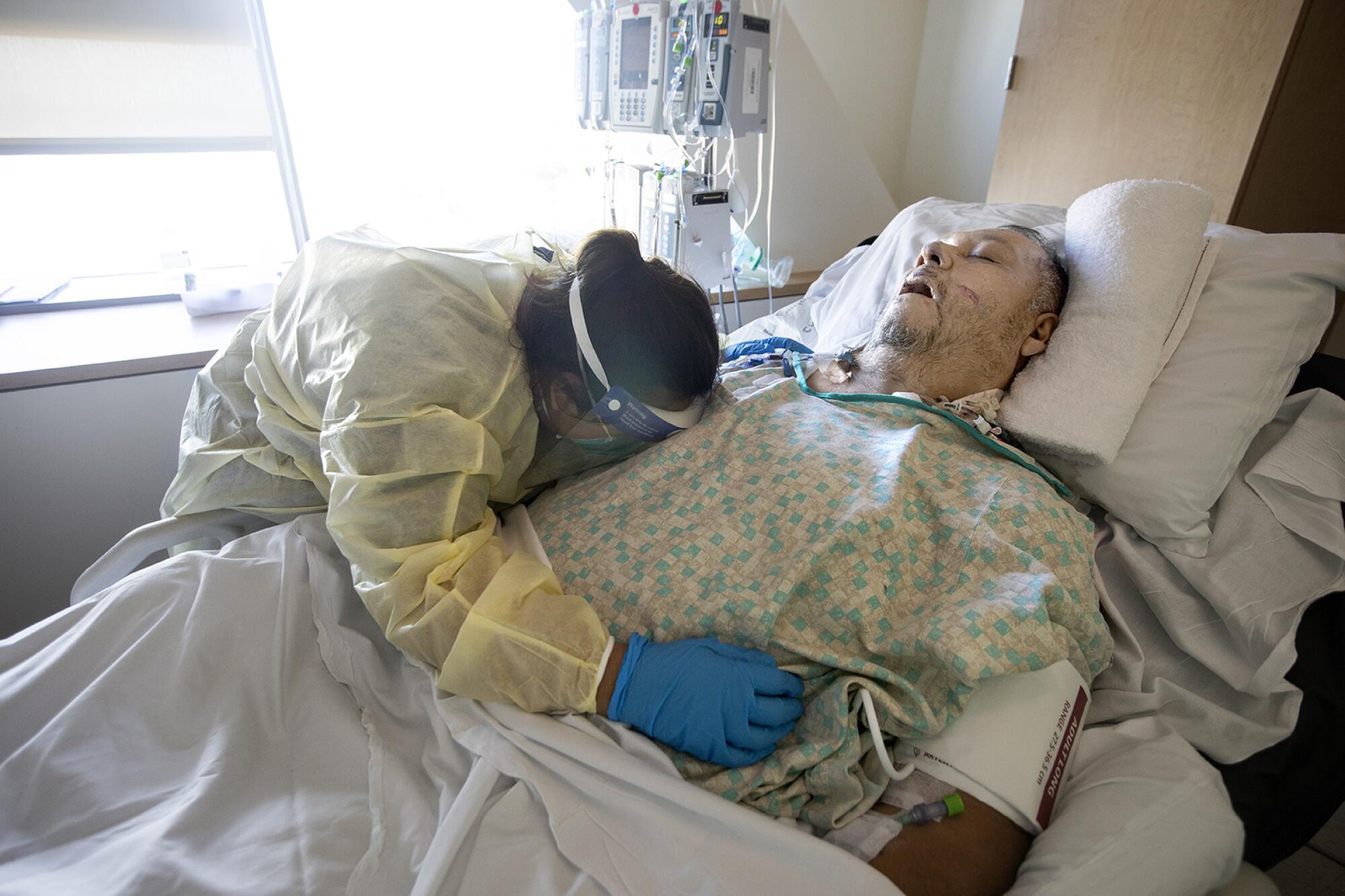
“Papa,” she said. She came to his side and gently closed his mouth. “I love you.”
She took deep breaths through her nose to keep from sobbing. She patted his arm and took care to tuck him better into his sheet.
“Wherever you are, I want you to be happy,” she said.
She clasped her father’s hand, hugged him and cried.
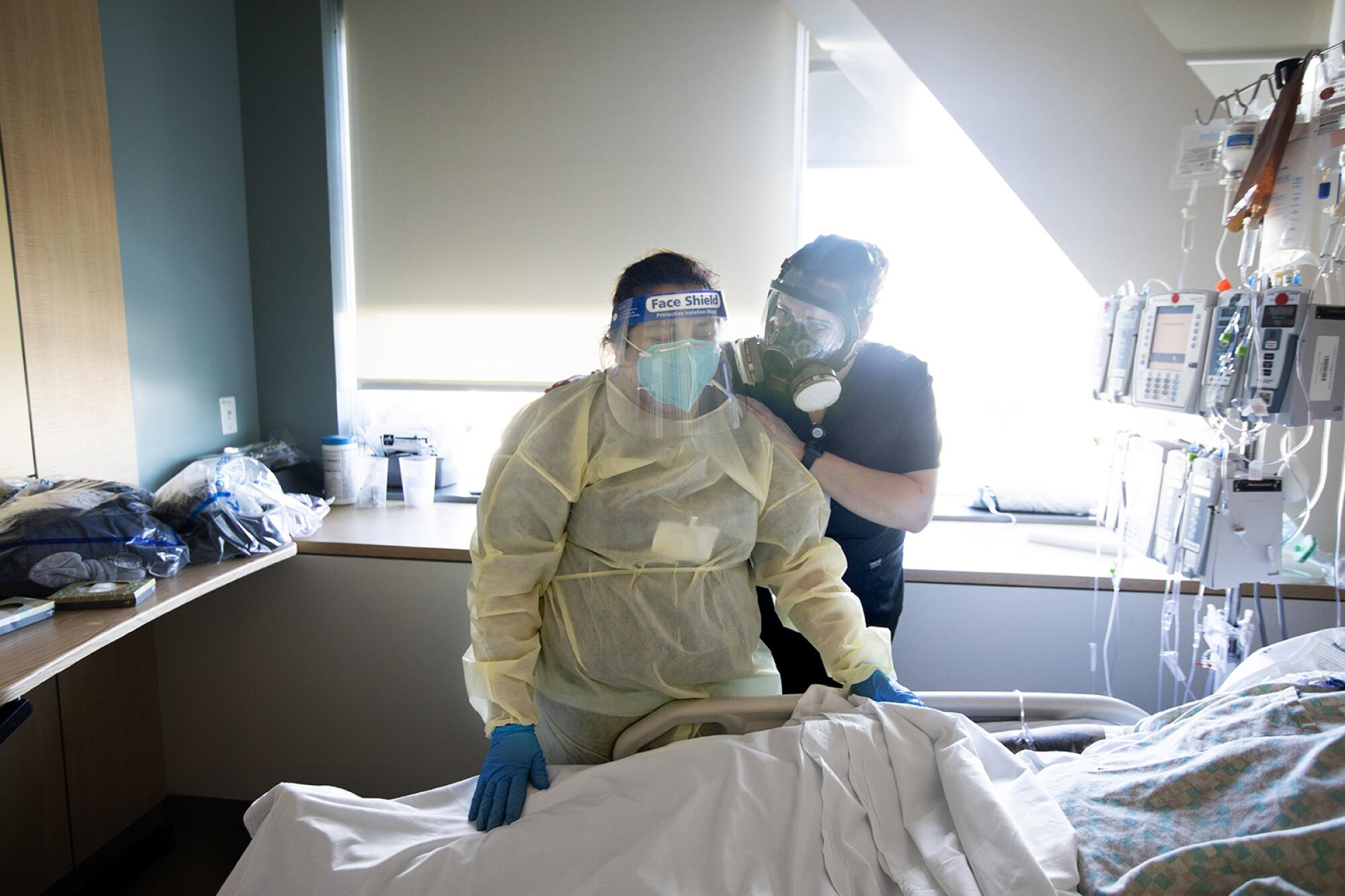
She didn’t know what she was going to tell her daughter. Hayley was so close to him, always sneaking in her abuelo’s room to check on him. His absence in their small apartment would be an inescapable hole.
Ana Zuñiga held him quietly and prayed.
“Please go in tranquility and peace. We are all going to be fine. We will always remember you.”
She patted her father’s arm.
“Adios Papa.”
More to Read
Sign up for Essential California
The most important California stories and recommendations in your inbox every morning.
You may occasionally receive promotional content from the Los Angeles Times.
